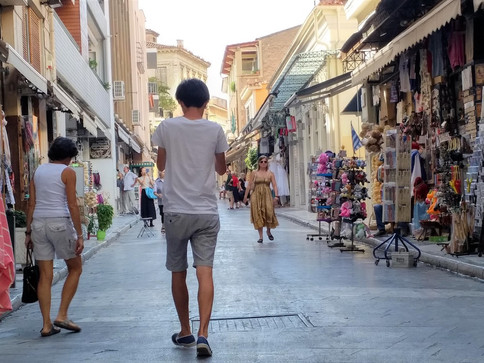A Flash Acquaintance with Plaka, The Heart of Athens
- Athena Lucero

- Oct 22, 2019
- 5 min read
Updated: Nov 29, 2020

With just one night in Athens before embarking on a road trip around northern Greece, my challenge was what to do with such little time. Take a bus tour of the capital or explore my surroundings on foot? After all, the best way to learn about a place is by poking around, meeting the locals, and getting lost.
Thank goodness for my burly taxi driver who showed me the lay of the land, even though he spoke little English and I spoke no Greek.
He pointed out city sights close to where I would be staying – the Acropolis, the Parliament House, the National Gardens, and Syntagma Square as I people-watched, awed by the dizzying number of motorcycles competing for space in snarled traffic. Turning onto an obscure narrow street, we stopped briefly in front of a long alleyway with shops and cafes. “Close…to…hotel!” my cabbie smiled.

My room was not yet ready – an opportune time to begin my self-tour of the neighborhood. Alongside smartly-dressed business people and tourists, I bee-lined in the direction of the cafes to fuel up with something to eat and strong Greek coffee (also called Turkish coffee, but when in Greece, it’s Greek).
I was in Plaka, the city’s oldest district built on top of ancient Athens on the slopes of the Acropolis also known as the “Neighborhood of the Gods.” The rocky outcrop rising above the city is home to the Parthenon built in honor of Athena, goddess of reason, who beat Poseidon, the moody god of the sea, in a contest to become the patron deity of the city. Athena’s offering of the olive tree was victorious over Poseidon’s undrinkable salty spring water (you go, girl).
I used to think there was only one acropolis. There are many throughout Greece, but only the one in Athens is called “The Acropolis,” the country’s most famous landmark.
And what I had thought was just another alleyway lined with vendors was no ordinary shopping lane.

It was Adrianou Street, the city’s oldest commercial road dating back to the Roman Emperor Hadrian. It’s been in continuous use ever since and according to archeological excavations, its layout follows that of the original ancient street. The marbled pedestrian street turned out to be a remarkable maze of shops, taverns and cafes.
An unexpected slice of history, this shopper’s haven has everything from souvenirs and t-shirts to high-quality jewelry, clothing, art, and furnishings made by local artists and designers. I enjoyed more warm Greek hospitality as shop keepers spent unrushed time showing me their wares and wrapping fragile purchases with such care.
Farther down Adrianou Street, I stood in the middle of an “intersection” having to choose between cafes as proprietors welcomed me to dine at their establishments. How could I say no to the charmer who motioned for my cell phone so that he could snap my photo? A glorious cup of coffee and a picture-perfect Greek salad -- the country’s quintessential rustic meal made with cucumbers, tomatoes, onions, olives, and heavenly Feta cheese sprinkled with oregano – was all that I needed to recharge.

Before heading to the new Acropolis Museum (a 10-minute walk away), I offloaded my Athens keepsakes at the hotel, picked up a city map, and was back pounding the marbled pavement (marble is everywhere).
Within minutes I was stopped in my tracks at the sight of a monumental arch two stories high hovering over fast-moving traffic. It was the Arch of Hadrian, or Hadrian’s Gate, that once spanned an ancient road leading to the Temple of Zeus, God of all gods. Made of marble, it was erected circa 132 AD marking the boundary between the ancient city and new Athens celebrating the arrival of the Roman emperor who loved all things Greek.
Known as the peaceful ruler, Hadrian advanced culture and literature in Athens and was the architect of the city’s rebuilding, including Hadrian’s Library designed in the style of the Roman Forum. Located at the opposite end of Adrianou Street, it was not a lending library, but a venue for study, lectures, intellectual exchange, and was the official repository for state documents. If I could go back in time to sit in on a philosophical discourse.
In my haste, I almost missed the sign pointing in the direction of the Acropolis Museum (designed by New York-based architect Bernard Tschumi) that opened in June 2009 at the foot of the ancient citadel and 1,000 feet from the Parthenon. It replaced the original museum built on the Acropolis in 1874 that had become too small to house the over 4,000 artefacts found during numerous excavations conducted around the Acropolis. It closed its doors in 2007.
The raised foundation of the new high-tech archaeological museum’s 26,900 square feet is supported by 100 pillars above a protected ancient site discovered during ground breaking. Excavations had uncovered two layers of housing and workshops dating back to the Byzantine period (330-1453 AD) and the Classical period (1775-1825). Walking on glass floors both outside and inside the museum, I delighted in viewing the breadth of the extensive ruins underneath my feet.
Inside, floor-to-ceiling glass walls let natural sunlight pour through. A minimalist look throughout the museum draws all attention to the antiquities on exhibit and on the first floor the rising slope of a wide hall was designed to give guests the feel of ascending the acropolis. And in the Parthenon Gallery on the top floor, the Parthenon is in full view.

A principal motivation for building the new Acropolis Museum has been for the eventual return of the Parthenon Marbles, also known as the Elgin Marbles, from Great Britain. In 1799 Lord Elgin, Great Britain’s ambassador to the Ottoman Empire, sought “permission” to move half of the Parthenon’s statues to England that were later sold to the British Government and have been on display at the British Museum ever since. The reason for not returning the precious relics to Greece, it has been claimed, was that the museum on the acropolis was too small to properly house them. That is not the case now.
Greece may soon see reunification of the marbles. In July 2016, a bi-partisan bill was introduced in the British Parliament to invalidate that improper acquisition over 200 years ago -- and to return the marbles to their rightful home.
The hours were passing quickly, yet there was so much more to experience – lively squares, flea markets, endless museums, great restaurants, and more people-watching. Hustling back to the hotel, I recalled what a staff member had told me that morning. “You must be sure to see the beautiful view of the Acropolis from the restaurant terrace…before sundown!”
Perhaps, on my return to Athens, I’ll pick up where I left off.
IF YOU GO:
For more information about Athens and Greece, visit www.visitgreece.gr
My Accommodation: New Hotel, a remake of the former Olympic Palace Hotel that first opened in 1958. The 79-room boutique in “The Plaka” pays tribute to the spirit of Plaka, the oldest district in Athens. https://www.yeshotels.gr/newhotel/
Published version: https://www.creators.com/read/travel-and-adventure/04/17/a-flash-acquaintance-with-plaka-the-heart-of-athens
PHOTO GALLERIES
Gallery 1 (6 images)
Gallery 2 (4 images)


























Comments